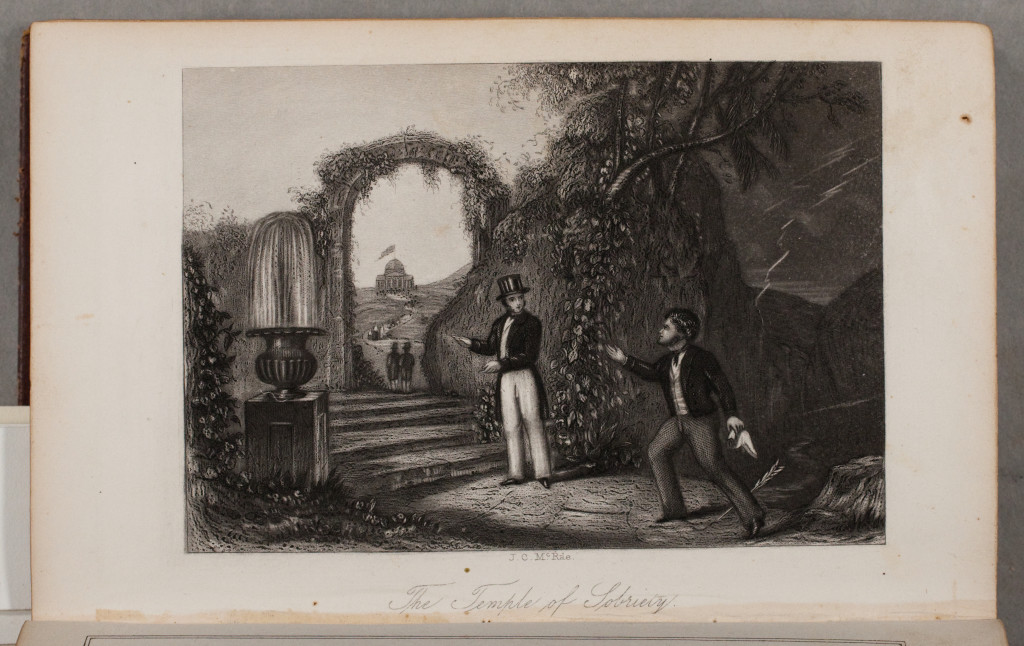After supper Pap took the jug, and said he had enough whiskey there for two drunks and one delirium tremens. – Huckleberry Finn
Delirium Tremens: the strange affliction of “being tormented by devils” (Root 14) while under the influence of alcohol.
The Book: The Horrors of Delirium Tremens by James Root; New York: Josiah Adams, 120 Broadway, 1844. [AAS Online Catalog record]
Found among the American Antiquarian Society’s collection of nineteenth century books, The Horrors of Delirium Tremens seeks to warn its readers of the dangers of alcohol. Root, the narrator, begins by explaining that his drinking patterns consisted of long periods of abstinence and days-long periods of intoxication; he would “refrain and not taste of any kind of spirits for a number of weeks, and then after drinking again for one night, it would perhaps be several days before [he] became perfectly sober” (14). He did this for nine years, seeing no problem with his pattern as he experienced no unusual side effects (except, of course, the “ordinary effects” [14]).

Although almost 500 pages long, Root’s book, unfortunately, has no illustrations. The image above is a political cartoon published by J.H. Varney titled “A Representation of the Progress of Intemperance in New-England, 1841” [AAS Online Catalog record]. The image below was engraved by J.C. McRae and is found in temperance gift books [AAS Online Catalog record].

In Root’s book, he recounts how after one particular drinking spree, he experiences the effects of Delirium Tremens. As he wanders from Manilus to Syracuse to Geddesburgh, he begins to hear strange, shrill noises and whispers. He strikes up conversation with the source of the noises, finding little to be unusual about his experience until he follows the voice to a group of “fiends” (32) and devils who threaten him with damnation. He climbs up a tree to try to escape them and even enlists the help of a local landlord, but to no avail. The hallucination does not fully pass until two weeks later. After it ends, he reverses his atheistic beliefs and prophesies to those whom he believes may be at risk of a similar experience.
The Context: Delirium Tremens was utilized as a piece of temperance propaganda, as J. C. Furnas writes in The Late Demon Run. Stories of frightening DT experiences worked as both urban legends and public service announcements. Sometimes exaggerated, but always effective, they scared men into becoming teetotalers. Furnas tells the story of a man who was jailed in Jefferson County, New York circa the 1830s. A “chronic alcoholic denied drink after a heavy spree,” (Furnas 118) he began to hallucinate and experience symptoms of withdrawal. His screams were so loud in the jail cell that three equally intoxicated prisoners were recruited by the jailer to keep him still. The recruited men, so disturbed by the man’s outbursts, vowed to become teetotalers. Indeed, even simply hearing the stories secondhand terrified men into abstaining from alcohol. Furnas recounts a particularly effective anecdote of a man who, believing a rat had run down his throat, used tongs to retrieve the imaginary rodent.
Captured in verse, the hallucinations are described:
See how that rug those reptiles soil! They’re crawling o’er me in my bed! I feel their clammy, snaky coil. On every limb—around my head—With forked tongue I see them play, I hear them hiss – tear them away! …
Delirium Tremens can result in hallucinations that are real symptoms of withdrawal. The stories surrounding the condition, however, have proved just as important as the physical reality. The myths build off of one another, creating increasingly terrifying stories. Root’s book is unique in that it is a firsthand account. Readers are subjected to nearly 500 pages of his hallucinations and prophesying. However, the book did not prove particularly popular as Root wrote only one other speech [AAS Online Catalog record] in addition to the novel, perhaps showing that the best legends are the ones with multiple storytellers.
Further Reading:
• The poem “The Devil and the Grog-Seller” on Google Books
• Remarks on the history and treatment of delirium tremens: From the transactions of the Massachusetts Medical Society [AAS Online Catalog record]
• The Life and Times of The Late Demon Rum [AAS Online Catalog record]
• Temperance poem “O, thou invisible spirit of rum! If thou had’st no name by which to know thee, we would call thee–Devil” [AAS Online Catalog record]
• AAS Fellow Xi Chen, a PhD Candidate in History at Northwestern University, is working on a project on “The Life and Times of John B. Gough” (who was a temperance orator)

Am seeking info about Francis (Frank) A.Lydston born Newburyport AM October 24,1819,died Dec 20,1902, Wauwatosa, Wisconsin
You may want to try contacting our reference department directly with this inquiry, since it does not seem directly related to this post. You can reach Kimberly Pelkey, Head of Readers’ Services, at kpelkey@mwa.org.